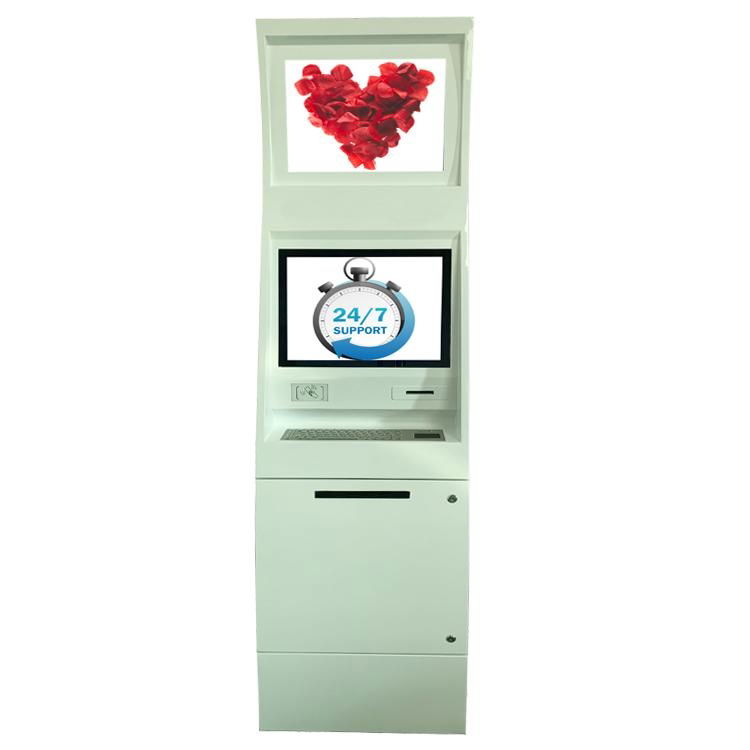Dual-screen touch kiosks are an emerging information interaction device that combines touch technology, dual-screen display, and information processing capabilities to provide users with a new and innovative experience. Let's explore the key features and application scenarios of this technology in more detail:
At the core of a dual-screen touch kiosk is the ability to deliver a dual-screen interactive experience. Typically, it is equipped with a primary screen and a secondary screen. The primary screen can display a wide range of information content, such as text, images, and videos, while the secondary screen is dedicated to accepting user touch inputs and enabling interactive operations. This dual-screen design not only increases the space for information display but also provides users with a more intuitive and flexible interface for interaction.
Compared to traditional single-screen information kiosks, dual-screen touch kiosks have significantly more powerful information processing capabilities. They are usually equipped with high-performance processors and large storage capacities, allowing them to smoothly play multimedia content and support complex interactive logic and information processing. For example, users can browse product information on the primary screen and then make selections and complete purchases on the secondary screen, with the entire process taking place within the dual-screen interaction.
Touch technology is another core feature of dual-screen touch kiosks. By incorporating advanced capacitive or infrared touch technologies, users can directly interact with the screens through actions like tapping, swiping, and zooming, delivering a more natural and intuitive user experience. Furthermore, some dual-screen touch kiosks support multi-touch capabilities, allowing users to leverage multiple fingers simultaneously for more complex gesture-based operations, further enhancing the flexibility and immersiveness of the interaction.
In addition to basic information display and interaction functions, dual-screen touch kiosks can also be integrated with various supplementary features to meet the needs of different scenarios. For instance, they can be connected to mobile payment, identity verification, and other systems to enable self-service checkout, identity authentication, and the like. These kiosks can also be equipped with cameras, speakers, and other multimedia devices to support video conferencing, voice interaction, and other interactive modes. Such functional expansions not only increase the value and usage of the devices but also bring users a more enriched and engaging experience.
The application scenarios of dual-screen touch kiosks are quite broad, primarily including the following areas:
Retail and shopping malls: In retail settings such as shopping malls and supermarkets, dual-screen touch kiosks can be used for product information display, self-service queries, order booking, and other functions, providing consumers with a more intelligent and convenient shopping experience.
Hospitality and tourism: Hotels, airports, and tourist attractions can deploy dual-screen touch kiosks to offer visitors information on local attractions, hotel services, flight schedules, and more, facilitating seamless information access and enhancing the overall travel experience.
Banking and finance: Financial institutions can utilize dual-screen touch kiosks for self-service banking, account management, investment consulting, and other financial services, enabling customers to conduct transactions and access information independently.
Public services: Government agencies, healthcare providers, and other public service organizations can install dual-screen touch kiosks to offer citizens and patients access to information, appointment scheduling, and various other administrative services, improving the efficiency and accessibility of public services.
Education and training: Educational institutions and corporate training centers can leverage dual-screen touch kiosks to deliver interactive learning experiences, provide access to educational resources, and facilitate self-paced training and development.
Entertainment and advertising: In entertainment venues, such as theme parks, cinemas, and shopping malls, dual-screen touch kiosks can be used for interactive games, digital signage, and immersive advertising, creating engaging and memorable experiences for visitors.
The versatility and customization capabilities of dual-screen touch kiosks make them a valuable tool across a wide range of industries and applications. As technology continues to evolve, we can expect to see even more innovative and user-centric features being integrated into these interactive devices, further enhancing their role in shaping the future of information access and service delivery.


